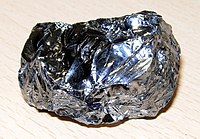
Photo from wikipedia
Mechanistic studies of the reduction of FeIII and FeII salts by aryl Grignard reagents in toluene/tetrahydrofuran mixtures in the absence of a supporting ligand, as well as structural insights regarding… Click to show full abstract
Mechanistic studies of the reduction of FeIII and FeII salts by aryl Grignard reagents in toluene/tetrahydrofuran mixtures in the absence of a supporting ligand, as well as structural insights regarding the nature of the low-valent iron species obtained at the end of this reduction process, are reported. It is shown that several reduction pathways can be followed, depending on the starting iron precursor. We demonstrate, moreover, that these pathways lead to a mixture of Fe0 and FeI complexes regardless of the nature of the precursor. Mössbauer and 1H NMR spectroscopies suggest that diamagnetic 16-electron bisarene complexes such as (η4-C6H5Me)2Fe0 can be formed as major species (85% of the overall iron quantity). The formation of a η6-arene-ligated low-spin FeI complex as a minor species (accounting for ca. 15% of the overall iron quantity) is attested by Mössbauer spectroscopy, as well as by continuous-wave electron paramagnetic resonance (EPR) and pulsed-EPR (HYSCORE) spectroscopies. The nature of the FeI coordination sphere is discussed by means of isotopic labeling experiments and density functional theory calculations. It is shown that the most likely low-spin FeI candidate obtained in these systems is a diphenylarene-stabilized species [(η6-C6H5Me)FeIPh2]- exhibiting an idealized C2v topology. This enlightens the nature of the lowest valence states accommodated by iron during the reduction of FeIII and FeII salts by aryl Grignard reagents in the absence of any additional coligand, which so far remained rather unknown. The reactivity of these low-valent FeI and Fe0 complexes in aryl-heteroaryl Kumada cross-coupling conditions has also been investigated, and it is shown that the zerovalent Fe0 species can be used efficiently as a precursor in this reaction, whereas the FeI oxidation state does not exhibit any reactivity.
Journal Title: Inorganic chemistry
Year Published: 2017
Link to full text (if available)
Share on Social Media: Sign Up to like & get
recommendations!